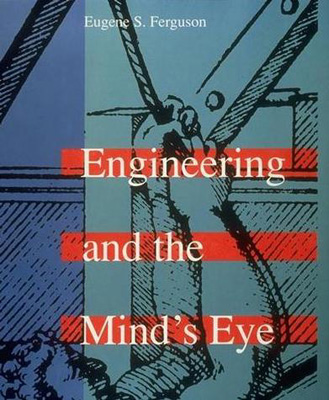

| ENGINEERING AND THE MIND'S EYE Eugene S. Ferguson Cambridge, MA: MIT Press, 1992 |
Rating: 5.0 High |
|||
| ISBN 0-262-06147-3 | 241pp. | HC/BWI | $24.95 | |
Since World War II, the dominant trend in engineering has been away from knowledge that cannot be expressed as mathematical relationships. The art of engineering has been pushed aside in favor of the "engineering sciences," which are higher in status and easier to teach. The underlying argument of this book is that an engineering education that ignores its rich heritage of nonverbal learning will produce graduates who are dangerously ignorant of the myriad subtle ways in which the real world differs from the mathematical world their professors teach them. |
So writes the author in his Preface. I couldn't have put it better myself. Every practicing engineer knows the incalculable aspects of the job he (or she) performs — the cultural and personal biases that bolster certain approaches to a problem at the expense of others; the iterations and patches required to get an apparently successful original design to work; the occasional flash of insight that reveals a bold, new solution, triggered by a chance conversation at lunch or by who knows what; above all, the art of engineering, which is that visualization (decidedly non-scientific) of the overall concept. That is what this book describes so well.
The first two chapters describe the nature of engineering design and its essential tool, the Mind's Eye of the title. Chapters 3 through 5 reprise the history of the art of engineering and its documentation from Greco-Roman times, illustrating this development with drawings of everything from axe blades to space stations. The ancients, despite having neither calculus nor computers, often achieved remarkable sophistication in their designs. We, with our panoply of modern analytical tools, quite often achieve remarkable stupidity in ours.
This last point is driven home in chapters 6 and 7, which close the book. Chapter 6 deals with the changing fashion in engineering education in America. Up until the 1960s, curricula emphasized the practical aspects of the discipline, routinely featuring hands-on design projects and field trips to installations such as working power plants. Then — for reasons Ferguson does not make clear, but documents thoroughly — it became unpopular to descend into this realm of the practical, and the courses began to focus exclusively on the closed-form, analytical aspects of engineering. This trend parallels the rise of the personal computer, and today it is common for engineers to be taught to use software packages that will, for example, crank out the complete stress analysis for a cantilever span of a bridge. What hidden assumptions the developer of the software made are unknown, and often ignored.
These last two chapters alone justify the cost of the book. Chapter 7 in particular makes clear the enormous cost such over-reliance on pure calculation can have.
The book is profusely illustrated and very well researched. I found the recitation of ancient texts in the middle chapters somewhat tiresome, but that may be just a matter of mood. I only spotted one typo: On page 148, Ferguson writes of "stress-verus-strain curves", omitting an "s" from versus. And on page 185, the curious word "rotative" is used.

 To contact Chris Winter, send email to this address.
To contact Chris Winter, send email to this address.